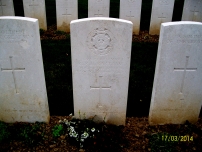| First Name: | Claud Robert Harry | Last Name: | BARTRAM | |
|---|---|---|---|---|
| Date of Death: | 07/10/1916 | Lived/Born In: | Camden Town | |
| Rank: | Rifleman | Unit: | London8 | |
| Memorial Site: | Royal Mail, Rathbone Place W1 Memorial | |||
Current Information:Age-23 105, College Place, Camden Town Warlencourt British Cemetery, France
The Battle of the Somme (July-November, 1916) By the beginning of October, 1916, the Battle of the Somme had been raging for three months. Thousands of men had already been killed or wounded or were simply missing, never to be seen again and and just a few square miles of the French countryside, all in the southern part of the battlefield, had been captured from the enemy. Mistakes had been made by the various commanders and would be continued to be made but there was no turning back as the British, Australians, South Africans, New Zealanders and Canadians carried on battering away at the German defences in the hope of a breakthrough, So it continued all the way through to November with nearly every battalion and division then in France being drawn into it at some stage. In the end the German trenches had been pushed back a few more miles along most of the line but the cost in lives had been staggering. By the end of the fighting in November, 1916, British Army casualties numbered over 400,000, killed, wounded and missing. The Battle of Transloy Ridge On 1st October, 1916, a new offensive was begun by the British Army. The Battle of Transloy Ridge was the last major operation fought during the battle of the Somme and it continued throughout the first three weeks of the month until the terrible conditions of rain, mud and cold coupled with the sheer exhaustion of the troops, brought things to a standstill. The aim had been to push the enemy further back to the next ridge of higher ground running between Le Transloy and Warlencourt. It was a very hard fight, progress was painfully slow, the casualty figure was shockingly high and the final objective was not achieved despite the best efforts of the attacking divisions. Three factors worked against its success. The first was the weather. It was simply awful. The second was the miles of war torn terrain which soon became a quagmire over which troops, guns, ammunition and all the other supplies had to cross to reach the front and keep the momentum of the offensive going. For the Germans, falling back on their own supply lines across relatively unscathed ground, this was not such a problem. The third factor was the new methods of defence employed by the enemy. They defended in depth without a well defined front line but instead setting up machine-gun nests in shell holes and other strategically important sites where just a few men could hold up an entire battalion. And of course, the German artillery had the whole area covered. 7th October, 1916, was a costly day for London on the Somme and by the end of it some 750 men from the capital had lost their lives and many thousands more were wounded. The second stage of the offensive, which had been delayed by the bad weather, was launched on this day and both London divisions, 56th Division and 47th Division were fully involved. At 1.30pm, 140 Brigade of 47th Division attacked from their positions just to the north of Eaucourt l’Abbaye towards the Butte de Warlencourt, an ancient burial mound near to the village of Le Sars. 8th London led the way but met such fierce machine-gun fire that they were unable to even reach their first objective, Snag Trench. The battalion was practically annihilated and the same fate befell 7th London and 15th London as they followed behind with the intention of passing through the ranks of 8th London on to the next objective. They got nowhere near it and they too sustained catastrophic casualties. All that was achieved was the establishment of a few posts on the Le Barque road, in touch with 41st Division on their right. Nearly 200 men from 8th London lost their lives in this brave but futile attack and over twice as many more were wounded. One of those killed in action was Claud Bartram. |
||||
| « Back to Search Results | ||||
| If you think any of the information shown here is incorrect, Click Here to submit your amends and comments | ||||




